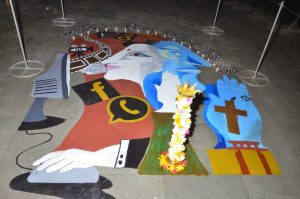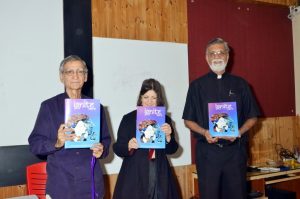UNESCO & Cardinal Paul Poupard Foundation
International Symposium 2014-2015
Impact of Media on Religion and Culture
St. Andrew’s College, Bandra
Concept Note: The link between social media and religion has attracted the interest of many scholars in the last decade. Lim and Putnam (2010:914), in their article ‘Religion, social networks, and life satisfaction’, state that social networks offer strong evidence for social and participatory mechanisms shaping religion’s impact on life satisfaction. Although the rise of online social networking appears to represent a new challenge to religious individuals and institutions, Verschoor-Kirss (2012:1) opines that it is wrong to assume that the interaction between religion and technology is always adversarial. Generally, technology can enhance religious practices through the expansion and creation of religious communities.
Verschoor-Kirss (2012:9) continues to say that it would appear, therefore, that to unilaterally set up religion and technology as incompatible fails to take into account the complex ways in which both support and erode the other. Technology can be beneficial to religion when it enhances the communal aspects of religion, and detrimental to religion when it degrades these communal aspects. While there are certainly other aspects of religion that technology might influence, it would appear that community represents the most important one. Given the fact that online social networks generally appear to enhance notions of community, it is perhaps inevitable that religious organisations and individuals will turn to them in ever-increasing numbers. Whether this turn towards digital communities might inadvertently erode physical communities is unclear, though certainly possible (Verschoor-Kirss 2012:9).
Religion is also related to self-disclosures. Bobkowski and Pearce (2011), in their article ‘Baring their souls in online profiles or not? Religious self-disclosure in social media’, examined personal attributes associated with religious identification as well as the overall quantity of religious self-disclosures. Zviadadze (2014:164) suggests that increased religiosity is manifested not only in a traditional form of piety (church attendances, observance of rituals) but also in the expression of religion in new media (clerics preaching on YouTube, a church bell as a ringtone on a mobile phone and a picture of a church as a desktop photo). Everton (2015:1) adds that social networks are crucial for the recruitment and retention of members of churches, the diffusion of religious ideas and practices, motivating individuals to volunteer in church work and become politically active, the health and well-being of people of faith.
The relationship between religion and social media has been discussed most recently. Faimau and Behrens (2016:66), for example, analysed the ways in which certain linguistic strategies and religious discourses used in Facebook posts, reviews and comments on a religion-based Facebook page create and shape the narratives of religious authority, religious identity and religious community. Brubaker and Haigh (2017:1) explored why Christians use Facebook for religious purposes and the need for engaging with religious content on Facebook. Coman and Coman (2017:129) show that in a post-secular society, the religious imagery is not only a ‘canopy’ inherited and kept because of convenience, but a cultural frame of the significant public sphere.
However, social networks do not offer only positive results; at times, it is a source of destruction. In fact, the use of social networks in religion has both advantages and disadvantages. Miller, Mundey and Hill (2013:227) mention sacred and secular influences on social networks’ involvement and social behaviours, such as being in school and participating in organisations that are more non-religious.
It is pivotal therefore, instead of completely shutting down the use of social media, to outline what the advantages and disadvantages of such usage are in order to address them. In order to address the disadvantages of social media in religion, Al-Mosa (2015:126) highlighted the value aspect of social media by studying the problems that hinder the activation of the role of social networks regarding youth values.

The International Symposium was held on the 28th January 2015 on ‘The Impact of Media on Religion and Culture’. His Grace, Archbishop Felix Machado was the chief guest, Dr. Margit Koves was the keynote speaker and Prof. Ram Punyani was the Guest of Honour. The panel discussion was seamlessly anchored by Rev. Dr. Fr. Gilbert D’Lima. The panelists included Rev. Fr. Josquim Fernandes, Dr. Zeenat Shaukat Ali and Prof. Ram Punyani. The release of the first magazine named ‘Ignite’ to enhance the spread of the message of peace and harmony, and highlight the efforts, joys, the commitment and teamwork that radiates through the organization.

The yearly journal was also released during the session entitled “Ethics and Society: An International Journal Religious and Cultures for Peace and Harmony” – Volume 3.
